The Patagonia region, located in the southern part of Chile and Argentina, is synonymous with nature. It is a land of vast national parks, where mountains, glaciers, and turquoise lakes dominate the landscape. This area is filled with attractions, and the calm demeanor of the locals encourages slow travel. One could spend months exploring every corner of Patagonia. However, if you don’t have that much time, you can plan an extensive two-week trip to Patagonia, ideal for discovering the main attractions of this region.

Panoramic view of the Vueltas river in Los Glaciares National Park on a hike from El Chaltén
Table of contents: ()
2-Week Itinerary in Patagonia: The Most Impressive Road Trip
After spending half a year traveling through Patagonia, I believe this would be the best itinerary for a first two-week trip to the south of South America:
- Day 1: Arrival in El Chaltén
- Day 2: Hike to Laguna de los Tres (El Chaltén)
- Day 3: Hike to Laguna Torre
- Day 4: Journey from El Chaltén to El Calafate
- Day 5: Perito Moreno Glacier
- Day 6: El Calafate to Puerto Natales
- Day 7: From Puerto Natales to Torres del Paine
- Day 8: Lake Pehoé (Torres del Paine National Park)
- Day 9: Hiking to Base Torres Viewpoint
- Day 10: Bus from Puerto Natales to Punta Arenas
- Day 11: Journey to Ushuaia
- Day 12: Tierra del Fuego National Park (Ushuaia)
- Day 13: Ushuaia Beagle Channel
- Day 14: Flight from Ushuaia to Buenos Aires
This two-week itinerary in Patagonia includes attractions from both Chile and Argentina. It is an ideal route to do independently without renting a car, as long-distance travel by bus is very easy. However, renting a car can be very practical for more freedom and making the most of your days in some parts of the trip.
Day 1: Arrival in El Chaltén
This two-week itinerary in Patagonia begins in El Chaltén, a small town of almost 1,000 inhabitants. This locality is surrounded by some of Patagonia’s most beautiful mountains, such as Fitz Roy or Cerro Torre, and is known as the trekking capital of Argentina.
To get to El Chaltén, you need to fly from Buenos Aires to El Calafate International Airport (FTE). From there, you can take a bus to El Chaltén, a journey that takes about two hours.
Depending on your arrival time in El Chaltén, you can take advantage of the first afternoon to go on a short and simple hike, such as the climb to Mirador Cóndor or the walk to Chorillo del Salto.
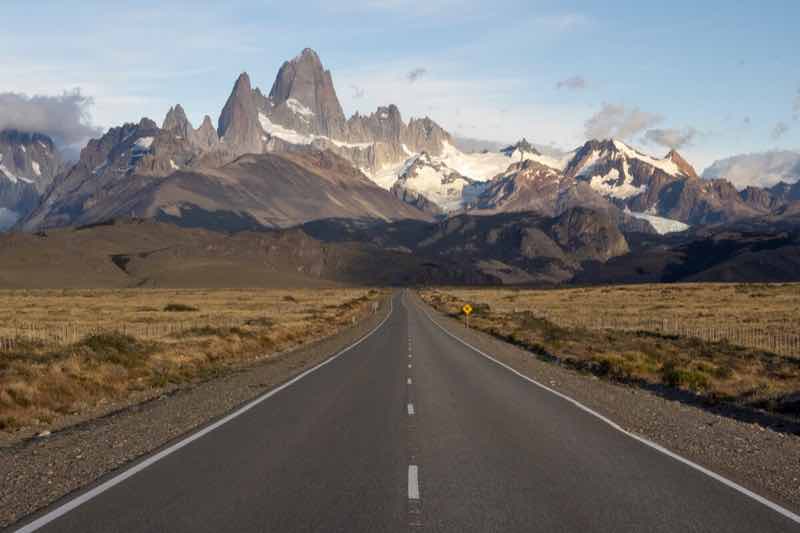
Fitz Roy in Patagonia, on the road to El Chaltén
Day 2: Hike to Laguna de los Tres (El Chaltén)
The main attraction of El Chaltén is the hiking trails in Los Glaciares National Park. However, these activities depend significantly on weather conditions, so it’s crucial to be flexible and adjust the routes accordingly. If the weather is favorable, you should take the most famous trail in the area: the hike to Laguna de los Tres. This 20-kilometer hike is somewhat demanding but rewards you with some of the best views of Fitz Roy.
Although it is most common to do this hike in one day, there is also the option of spending the night at Poincenot Camp (two kilometers from the lagoon) to hike to the lagoon at night and witness the sunrise there, seeing Fitz Roy illuminated by the first rays of the sun.

Sunrise at Laguna de los Tres in Los Glaciares National Park (Argentina)
Day 3: Hike to Laguna Torre
The second must-do excursion in El Chaltén is the hike to Laguna Torre, from where you can admire the majesty of Cerro Torre and the Fitz Roy glacier. This trail is somewhat easier than the previous day’s but equally impressive. If you have enough time, you can extend the hike a bit and climb from the lagoon to the Maestri Viewpoint.
Again, for those seeking a more immersive experience, you can spend the night at Agostini Camp and marvel at the sunrise at the lagoon the next day. In fact, one option is to do a three-day (two-night) trek, linking Poincenot Camp with Agostini Camp via the Madre e Hija Lagoons trail.
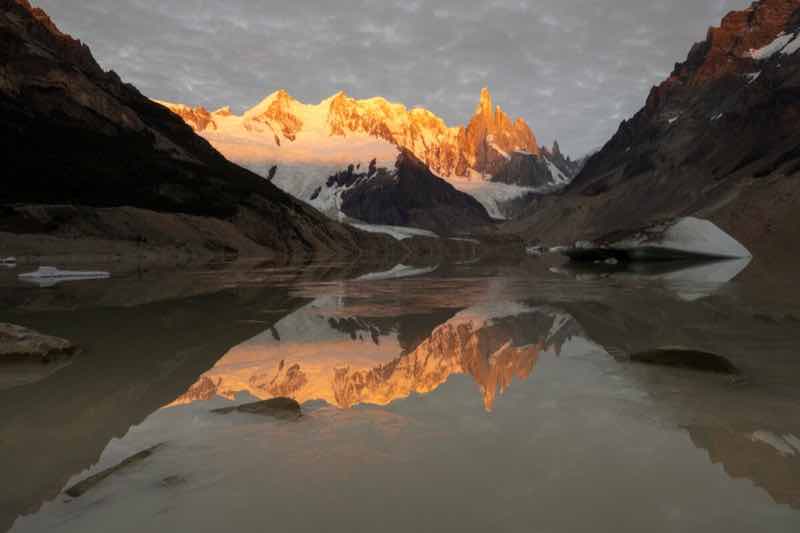
Sunrise at Laguna Torre, a must-do hike on a 2-week itinerary in Patagonia.
Day 4: Journey from El Chaltén to El Calafate
It’s time to change areas and take the bus from El Chaltén to El Calafate. This is one of the most popular routes in the area, so it is important to have your ticket purchased about fifteen days in advance (especially during the high season).
El Calafate is a tourist town, mainly famous for being the closest town to the Perito Moreno Glacier. During your first afternoon there, you can take advantage of walking around the city center and enjoying the variety of cafés and restaurants. Another good plan is to watch the sunset at the Nimez Natural Reserve or spend the afternoon visiting the Glaciarium Museum.
Day 5: Perito Moreno Glacier
It’s time to visit the Perito Moreno Glacier, the third-largest glacier in Argentina and one of South America’s great symbols. The glacier is located 80 kilometers from the town and can be reached by bus or rental car.
Upon arrival, there are wooden walkways that can be traversed on foot to enjoy an excellent perspective of the massive ice. It’s worth taking a leisurely stroll and spending a long time observing the glacier to witness the spectacular icefalls.
For a different perspective, you can take a boat trip on Lake Argentino to get closer to the glacier. Being on the water level makes it easier to appreciate the vast dimensions of the ice mass.
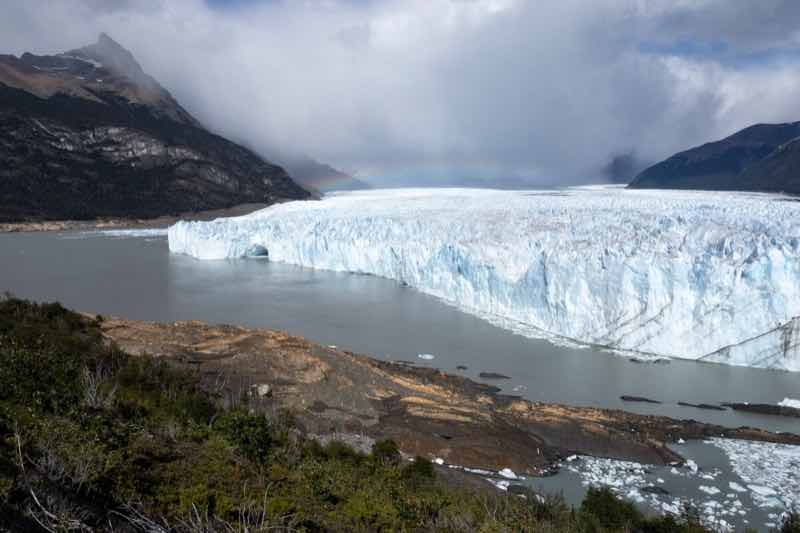
Panoramic view of the Perito Moreno Glacier in Argentine Patagonia.
Day 6: El Calafate to Puerto Natales
During the sixth day of the 2-week itinerary in Patagonia, it’s time to change countries, going from El Calafate to Puerto Natales, located in Chile. This journey can be comfortably done by bus, taking about eight hours.
Upon arrival in Puerto Natales, I recommend you rent a car for the next three days of the trip (it’s important to have booked it in advance as there is a limited number of vehicles available). Then, you can enjoy the rest of the afternoon by strolling along its quiet waterfront, overlooking the Señorito Channel, or exploring the town’s tourist center.
Day 7: From Puerto Natales to Torres del Paine
Although you can reach Torres del Paine National Park by bus or in a tour, the best way to explore all its corners and landscapes is by renting a car.
To make the most of the first day, it’s best to wake up early and arrive at the Pingo Nursery before 9 a.m. to catch the first boat to Glacier Grey. Then, you can drive to the Pehoé Lake area, where you can take some short hikes, such as to Condor Viewpoint or Cuernos Viewpoint. As the evening falls, there’s nothing more impressive than watching the sunset from the lake.
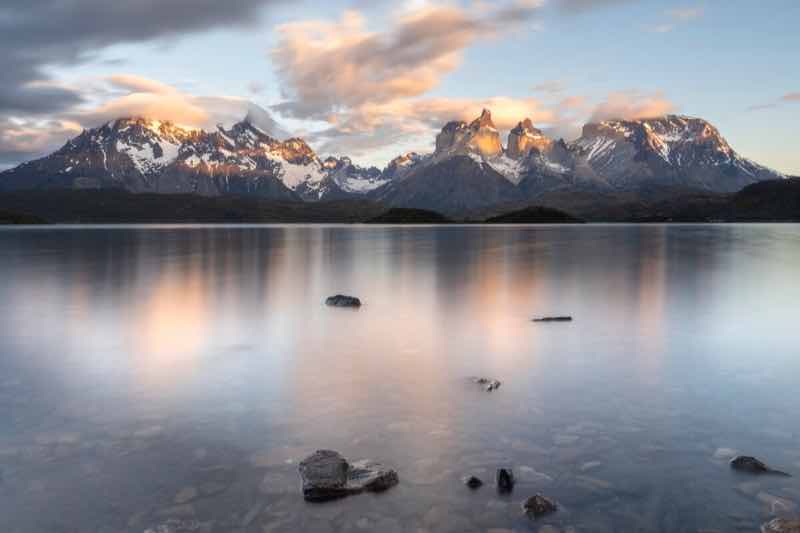
The Paine Massif within Torres del Paine National Park, seen from Lake Pehoé.
Day 8: Lake Pehoé (Torres del Paine National Park)
Continuing the car journey through Torres del Paine, on the second day, you can drive to the Pudeto Sector to take a catamaran to Paine Grande Refuge. This journey costs $30 USD per trip and can only be paid in cash.
In addition to enjoying this scenic navigation, from Paine Grande Refuge, you can go on several excursions: one option is to hike to Glacier Grey viewpoint, where you can appreciate the glacier’s enormous extension, and another option is to walk to the French Valley.
In the afternoon, you should take the catamaran back to the Pudeto Sector and spend the night at the camping or hostel in Lake Pehoé.
Day 9: Hiking to Base Torres Viewpoint
If the weather is favorable, this is an unforgettable day of the 2-week itinerary in Patagonia. Again, it’s best to wake up early to arrive at the Hotel Las Torres area, where the famous trail to Base Torres Viewpoint begins.
The hike is demanding, with an approximate duration of 8 hours round trip. The trail traverses varied landscapes, from valleys and forests to the final moraine, which is the steepest part. Upon reaching the viewpoint, the sight of the three granite towers rising majestically above the lagoon is an unforgettable reward.
After enjoying the scenery and taking a well-deserved break, the return is made along the same path.
Upon reaching the bottom, you can take advantage of the afternoon to drive to Laguna Amarga and Paine Waterfall before starting the car journey back to Puerto Natales, where you should return the rental car.
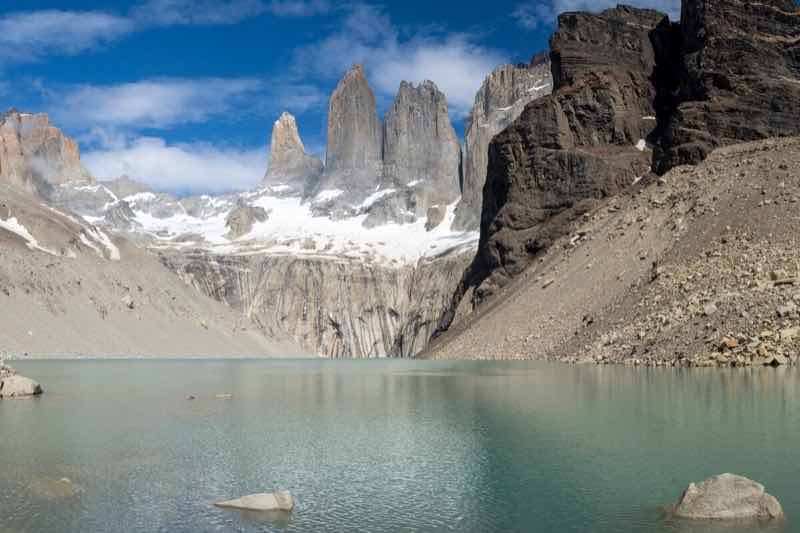
The most famous view of Chilean Patagonia: the viewpoint of the Three Towers (Torres del Paine National Park).
Day 10: Bus from Puerto Natales to Punta Arenas
To continue the journey through Patagonia, it’s time to head south. The route from Puerto Natales to Punta Arenas can be done by bus and takes about three hours. You should leave early to arrive in Punta Arenas around noon.
Arriving at noon in Punta Arenas allows enough time to take an afternoon excursion to Magdalena Island, with the boat departing at 2:30 p.m. This island, located in the Magellan Strait, is home to a large colony of Magellanic penguins. Walking among these wonderful birds and observing them up close is an unforgettable experience in Patagonia. Additionally, during the journey through the Magellan Strait, it’s possible to spot sea lions, dolphins and even whales.
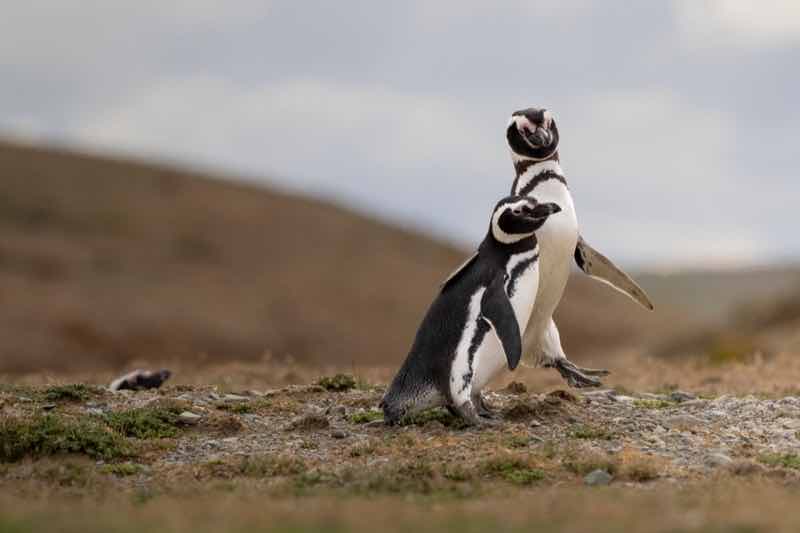
Two Magellanic penguins on Magdalena Island.
Day 11: Journey to Ushuaia
Following the 2-week itinerary in Patagonia, it’s time to make one last bus journey to reach Ushuaia, the famous city at the end of the world.
This bus journey takes about 12 hours, with buses departing from Punta Arenas at 8 a.m. It’s a very scenic route, crossing the Magellan Strait to reach Tierra del Fuego Island where you have to cross the border from Chile to Argentina.
At the end of the journey, the landscape becomes increasingly beautiful and surprising, especially when the Andean Fueguian mountains that surround Ushuaia appear on the horizon.
Day 12: Tierra del Fuego National Park (Ushuaia)
About 12 kilometers west of Ushuaia lies Tierra del Fuego National Park, which covers almost 70,000 hectares of varied ecosystems. This park protects a rich biodiversity, including Patagonian forests, lagoons, bays, and mountains.
You can reach the park by rental car, bus, or taxi. Once there, there are numerous hiking trails to explore. Among the most notable are the Pampa Alta Trail, the Coastal Trail, and the Hito XXIV Trail. I also highly recommend you walk or drive to Lapataia Bay, where the famous Route 3 ends, offering a wild coastal landscape with an interesting relationship with the indigenous populations.
In the afternoon, upon returning to Ushuaia, you can stroll around the port area. Here you’ll find the famous city sign, and you can also book boat trips through the Beagle Channel.
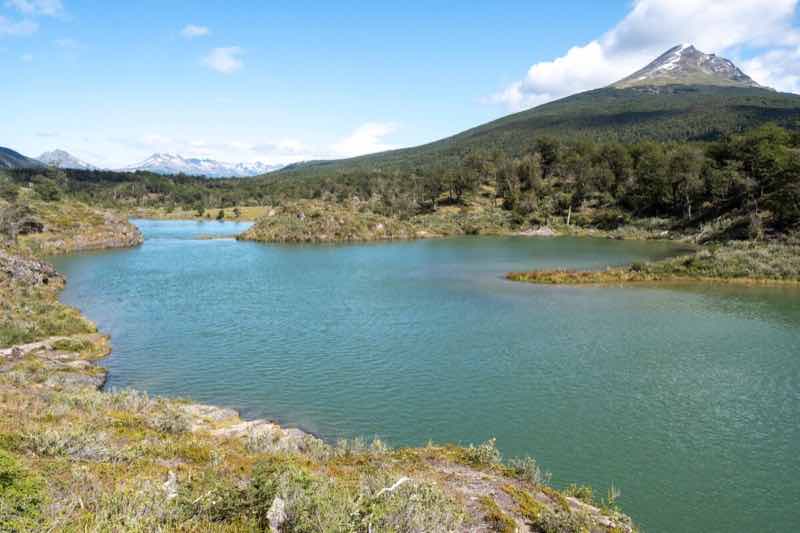
Laguna Verde in Tierra del Fuego National Park, on the outskirts of Ushuaia.
Day 13: Ushuaia Beagle Channel
During the last full day of the 2-week itinerary in Patagonia, there’s nothing more special than enjoying a boat trip through the Beagle Channel, from where ships also depart to Antarctica.
There are two types of trips through the Beagle Channel. The most common is a navigation of about two and a half hours, visiting Bird Island, Seal Island, and Les Éclaireurs Lighthouse. The alternative (only available from October to April) is a four-hour navigation that also includes a landing on Martillo Island, where there is a colony of two species of penguins (Magellanic penguins and Gentoo penguins).
In the afternoon, you can take an easy excursion to Martial Glacier.
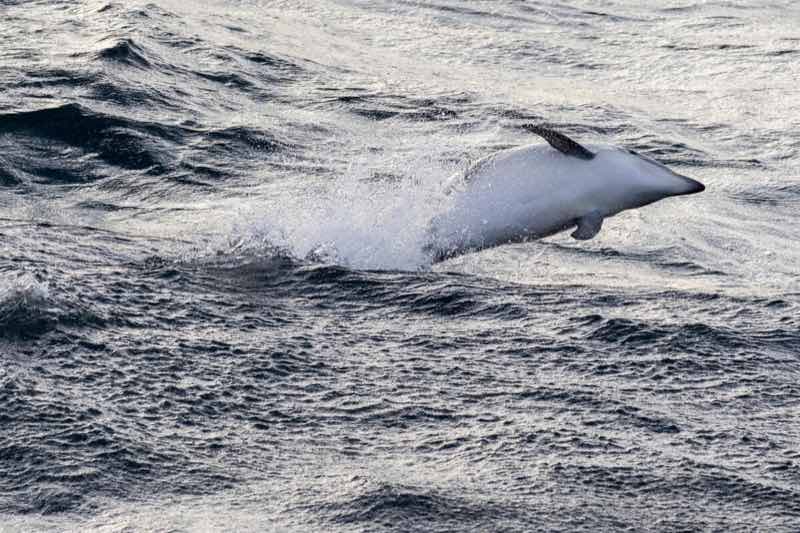
A dolphin in the Beagle Channel on a boat tour from Ushuaia.
Day 14: Flight from Ushuaia to Buenos Aires
This intense and varied journey through Patagonia ends with a flight from Ushuaia to Buenos Aires, where most international flights depart from in Argentina. Ushuaia Airport is about 15 minutes from the town
Practical Information to Enjoy the 2-Week Itinerary in Patagonia
Best Time to Visit
The best time to take a trip to southern Patagonia is from mid-December to early March, coinciding with the austral summer. During this season, the weather is much more pleasant, and the days are long.
January and February are peak tourist season months, so it’s important to note that prices are higher, and occupancy rates are also higher. Therefore, if you’re traveling during these months, it’s necessary to book accommodations, transportation, and activities well in advance.
Getting Around
During a Patagonia itinerary, it’s most common to travel by rental car or bus (the two main companies are Bus-sur and Taqsa).
For a short two-week trip, it’s usually better to take long journeys by bus and only rent a car for specific parts of the trip.
In the case of a longer route through Patagonia, renting a car for more days might make more sense. In this case, if you plan to cross the border between Chile and Argentina by car, you must notify the car rental company in advance. This usually involves a supplement of $100.
Another increasingly popular option, especially for longer trips, is the alternative of traveling by renting a campervan or motorhome, as this allows for cost savings on accommodations and sleeping in stunning natural locations. If you want to travel this way, there are different campervan rental companies in Punta Arenas.
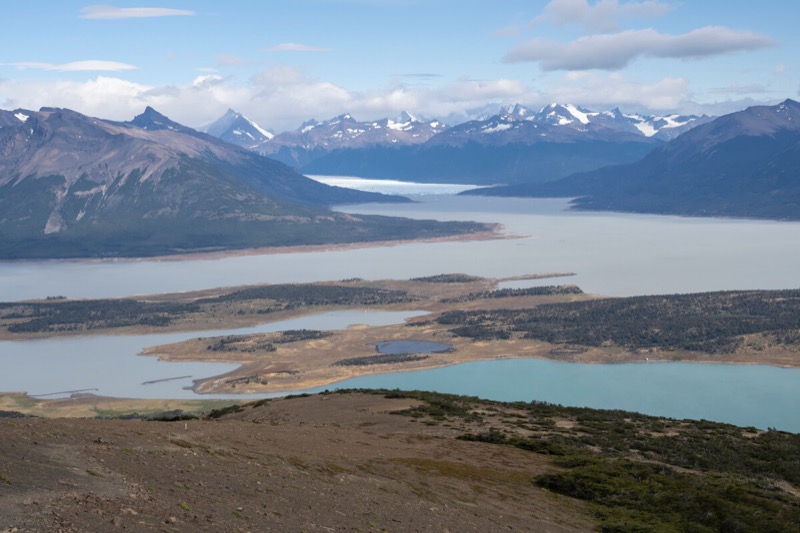
Panoramic view of Los Glaciares National Park, one of the most impressive in Patagonia.
Daily Budget
Patagonia is not a cheap destination. In general, for this 2-week itinerary, staying in mid-range accommodations, it’s normal to spend between $75 USD and $90 USD per person per day.
- Buy Travel Insurance
- Search for Great Tours HERE
- Book Your Accommodation HERE
- Get an eSim to be able to use your smartphone abroad.
- Get a universal plug adapter
- Get a Car Rental
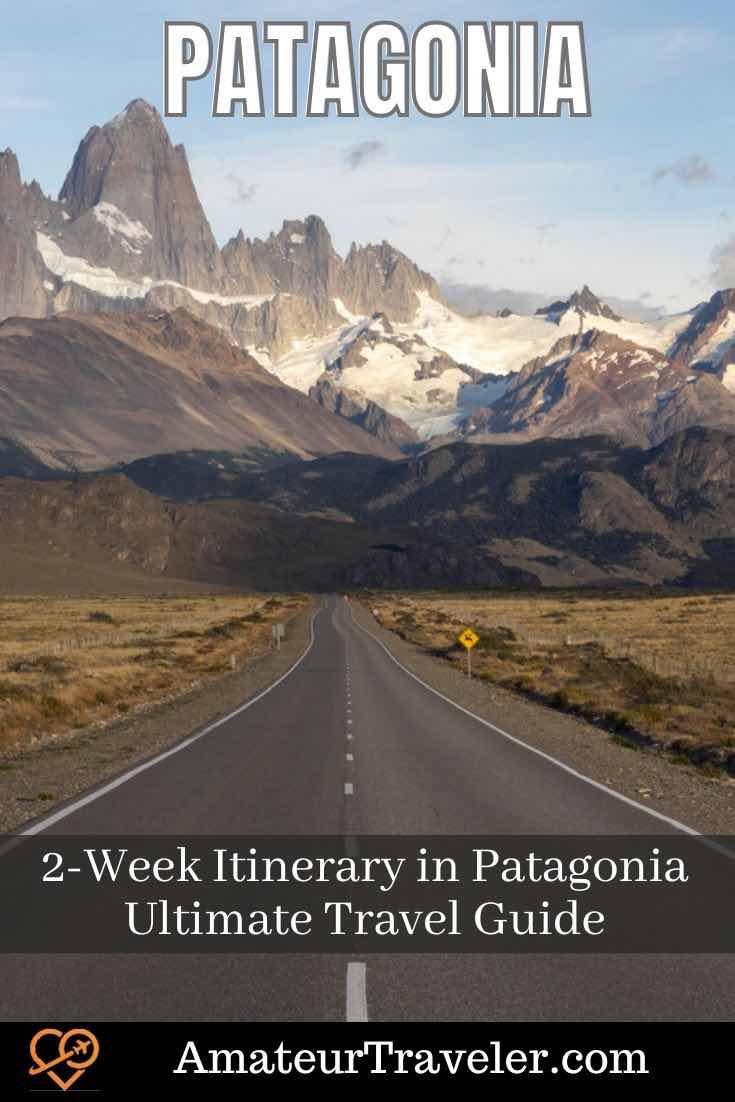

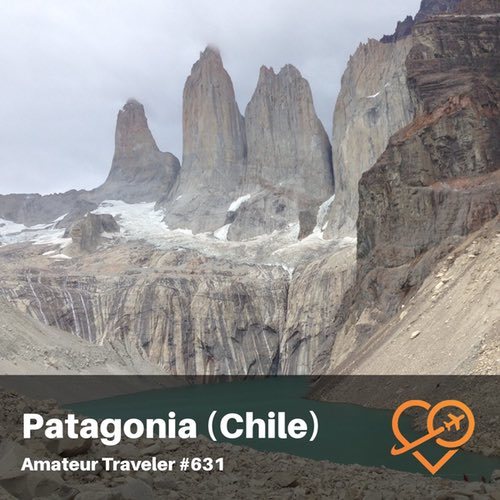 Travel to Patagonia in Chile – Episode 631
Travel to Patagonia in Chile – Episode 631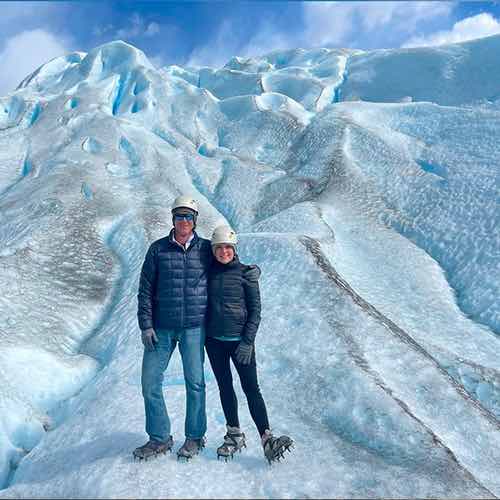 Patagonia Trip Planning for Seniors
Patagonia Trip Planning for Seniors Travel to Patagonia in Argentina – Episode 531
Travel to Patagonia in Argentina – Episode 531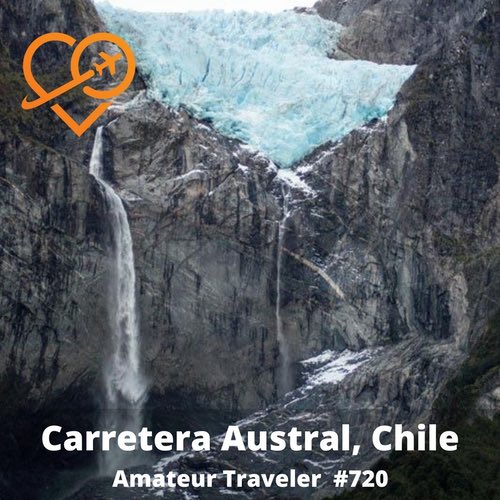 Driving the Carretera Austral, Chile – Episode 720
Driving the Carretera Austral, Chile – Episode 720

?SMA?L AKSU
Says:October 20th, 2024 at 1:13 pm
Hello,I didn’t find “Pingo Nursery” on google maps to catch a ferry to go from Puerto Natales to Torres del Paine. Can you mark it on a map and share it with me.
Thank you in advance.
?SMA?L AKSU
Says:October 20th, 2024 at 1:29 pm
Since I don’t understand some points, I want to ask you below.
Is it possible to come back to the boarding point after taking the ferry on the 7th day of the 2-week trip that you suggested for Patagonia?
Is it possible to walk to the Condor/Cuernos viewpoints from the point where you first boarded the ferry?
Where can we stay the night in Torres del Paine, after returning to the ferry boarding point?
Thank you in advance.